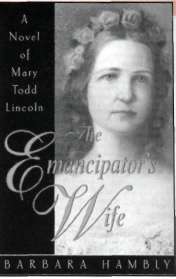 |
Home | Search | Browse | About IPO | Staff | Links |
 |
Home | Search | Browse | About IPO | Staff | Links |
|
BOOK REVIEW  Tragically plump The Emancipator's Wife: By Barbara Hambly Poor Mary Todd Lincoln. Her life was a series of tragic events. Her mother died when she was six years old. Her father remarried, providing her with an archetypal wicked stepmother and a passel of stepsiblings who took up all her father's attention and affection. She and her husband endured the deaths of two of their four sons. She was sitting next to Lincoln when he was shot dead by John Wilkes Booth. She suffered alone the death of one of her remaining sons and betrayal by the other, who had her committed to a lunatic asylum. On a more frivolous note, she was short and plump in an era when great beauties had 20-inch waists. The elaborate fashions of the day with their voluminous hoop skirts did not flatter her, much to her chagrin, because she longed to be as elegant as her social rivals in Springfield and Washington. None of these difficulties, however, can compare to the indignity of being the subject of an "historical" novel, The Emancipator's Wife, by Barbara Hambly. Ms. Hambly's usual genre is fantasy fiction. She is a past president of the Science Fiction Writers of America and the winner of the Romantic Times 2004 Career Achievement Award. Her characters include vampires, dragons, voodoo queens, and damsels in distress. Her Ben January mysteries, eight novels set in New Orleans in the 1830s, put fictional characters in historic settings. With titles like Sold Down the River, Die Upon a Kiss, and Wet Grave, the books are almost, but not quite, bodice rippers. Ms. Hambly's devoted fans love this sort of thing. Writing about a First Lady of the United States poses some difficulty for an author of fantasy fiction. Historical documents are available to provide rich detail about the life and times of Mary Todd Lincoln. Ms. Hambly availed herself of only a few of them. She used her vivid imagination to create preposterous events involving Mary Todd Lincoln. This technique may work well when the author is inventing a character, but the blending of fact and fantasy doesn't help the reader know Mrs. Lincoln better. Did she really put spiders in her stepmother's bed? Did she really seduce Mr. Lincoln after a session of heavy petting on the Edwards' sofa, and then, the very next morning, announce that she was with child, thereby forcing him into a shotgun wedding? Did she really suffer from severe bladder problems that forced her to use the chamber pot as many as a dozen times each night? Please, don't tell me. There is such a thing as too much information. But, for 624 pages, Ms. Hambly goes on, and on, with invention, embellishment, and fabrication. The book's extremely unflattering portrayal of Mary Lincoln is not its only problem. Ms. Hambly doesn't seem to be concerned much with accuracy. Any reader from central Illinois would wonder at her description of Springfield in the 1830s. She places the village on the bluffs overlooking the Sangamon River, while it was actually several miles from the bluffs and the river. She mentions Lake Springfield, a man-made lake that was not constructed until the 1930s. She puts Pontiac in Dewitt County, rather than where it belongs in Livingston County. Students of history might be struck by the anachronisms. Ms. Hambly describes Abraham Lincoln packing his belongings in cardboard boxes after his marriage to Mary Todd in 1842. Cardboard was not patented until 1891. Readers more accustomed to literature than fantasy fiction may find the prose a bit lurid. Here is Ms. Hambly describing Mary Todd's increasing affection for Mr. Lincoln: "Love grew in her like weeds in a hot, wet June." For the reader who wants to learn more about this period in history, Jean Baker's excellent biography, Mary Todd Lincoln, is a much better choice than The Emancipator's Wife. Well written and meticulously researched, it is a sympathetic portrayal of one of our most troubled and difficult First Ladies. And, at 448 pages, it is nearly 200 pages shorter than Ms. Hambly's tragically plump fiction. —Ann Hamilton 20 Illinois Heritage |Home|
|Search|
|Back to Periodicals Available|
|Table of Contents|
|Back to Illinois Heritage 2006|
|